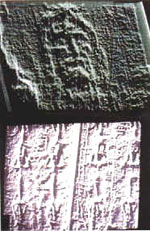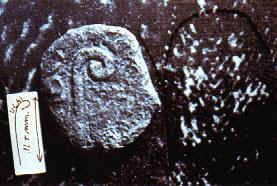THE HOLY SHROUD OF TURIN
Appendices
THE MYSTERIES OF THE BRITISH MUSEUM
Let us remember that the British Museum enjoys a solid reputation as a forger. A masonic bastion of scientific atheism, its militant Darwinism has for long served as its religion. To give it a “ scientific ” foundation and guarantee its definitive triumph over the Catholic doctrine of creation, Arthur Smith-Woodward and Charles Dawson, the Mike Tite and Teddy Hall of the Belle époque, did not hesitate to set up, at great expense, the hoax of the “ Piltdown Man ”, which deceived the scientific world for forty years, from 1912 to 1953. They put together some palaeontological remains from collection pieces made up to create the “ missing link ” in the supposed chain from monkey to man: the “ Dawn Man ”: a human skull and a simian jaw. They benefited from the eager collaboration of the ecclesiastical world – even then! – in the person of the young Jesuit, Teilhard de Chardin, and of the Franciscan, Bergounioux.
Silencing every objection raised by the most renowned palaeontologists of the period – the Englishmen Keith and Waterstone, and the famous Frenchman, Marcellin Boule, convinced transformist though he was – the British Museum succeeded, on the strength of its prestige alone, “ above all suspicion ”, in sustaining this enormous trickery, even shaking Boule himself and finally winning over his successor who headed the Institute of human palaeontology, Henri Vallois, professor at the National Museum of natural history and director of the Museum of Man, by means of a fraudulent fluorine dating!
If there is an institution in the world which the Church should have challenged, it is the British Museum ! On the other hand, if there is an institution above all suspicion, on the unanimous admission of the international scientific community, it is the Pontifical Academy of Sciences. But it was the latter that was ousted in favour of the former!
Letter from Dr. Tite to Jacques Évin, in which he asks him to obtain a piece of 14th century cloth identical in every respect to that of the Holy Shroud, so that it might be mistaken for it. Here we have a carefully crafted plot well on its way to come up with a false Holy Shroud ! and capable of providing the result that will allow them to proclaim: the “ shroud of Turin ” was fabricated in the Middle Ages; it never enveloped the Body of Christ!
The British Museum Research Laboratory
Dr. J. Évin.
Radiocarbon Laboratory
Villeurbanne, France.
Our reference: MST/IMP
London, February 12, 1988
Dear Dr. Évin,
Thank you very much for your most helpful and encouraging letter of February 8.
Certainly, limiting the number of laboratories involved in dating the Shroud makes my task somewhat easier (my emphasis!).
I would certainly very much welcome any assistance that you can give in obtaining a mediaeval control sample, which is as similar as possible in terms of weave and colour as the Shroud, (again I emphasise this search for a double, a likeness to the Holy Shroud!) since at present, I am not certain whether the British Museum will be able to provide such a sample (fancy that! and why?)
Firstly, therefore, in answer to your specific questions:
1. The total sample would need to be 6 cm² (i.e. about 120 mg.)
2. The material of the sample should be linen. I enclose a photocopy of some photographs which give some indication of the weave of the Shroud (again, I emphasise).
3. We are looking for a sample which dates from the 13th or 14th century AD, preferably from the 14th (again, I emphasise).
4. The historical precision should obviously be as good as possible, but one would certainly consider (?) samples with an age range of fifty to a hundred years (everything is so strange in this letter that, again, I must emphasise these mysterious words).
5. There is no need for the sample to come from a well known textile.
6. I suppose I could come to France to collect the samples. The idea certainly appeals to me. But I do not really think that this is necessary (there being the risk of me and my double not passing unnoticed!). It would probably be satisfactory to use the postal service (incognito consignment).
7. I think that one would want to include the name of the museum that provided the sample in the final publication, if this were in fact possible (there's the alibi).
On the bases of these answers, it would seem that your third suggestion as a source of possible material, the Cluny Museum in Paris, would be the most suitable. I have, therefore, written a letter to Mme Joubert-Caillet – copy enclosed – asking her if she would be able and willing to help in this matter.
Again, thank you very much indeed for your kind offer of assistance, which is very much appreciated. As you say, I hope that the project will give us an opportunity to meet again.
With best wishes, yours sincerely,
Signed: M.S. Tite.
THE INTRIGUES OF THE BRITISH MUSEUM
by David Boyce
On October 14, 1988, a press conference was held at the British Museum at which the Holy Shroud was declared to be a hoax by Dr. Michael Tite, at that time director of the British Museum research laboratory, accompanied by Professor Edward Hall, then director of the Research Laboratory for Archaeology and History of Art at Oxford University, and by the physicist Robert Hedges.
You all saw the photograph in the CRC of these three gentlemen sitting very complacently before a blackboard on which was chalked the dates 1260-1390, followed by an exclamation mark. We need to bear in mind this very well known fact, because what follows will show just how the British Museum tried to pass itself off as neutral in this whole affair.
The English public, with its innate anti-Catholic prejudice, had no difficulty in accepting this news, for Professor Hall, it seems, had already leaked it to the Evening Standard of August 26, 1988, where it was front page news proclaimed in big headlines, long before publication of the official report and without consultation with the American and Swiss laboratories.
After October 13, we had to wait four months for the official report to appear, a four page article in the review Nature, not subject to peer control by the scientific world. I then telephoned Professor Hall in Oxford to ask when we would receive the detailed report of the tests performed in Oxford on the linen of the Holy Shroud. He very curtly replied that there would be no further report other than that published by Nature.
In the meanwhile, there was a change of personnel. Professor Hall resigned and would answer no more questions on the subject. Dr. Tite replaced him as Director of the Research Laboratory for Archaeology and History of Art at Oxford, and Dr. Mark Jones took over from Dr. Tite at the British Museum. Then, on March 25, 1989, The Daily Telegraph revealed that £1 million sterling had been donated by rich friends of Hall's to provide for Tite's post at Oxford. The day of the payment: Good Friday! One can guess who these “ rich friends ” are: by choosing the pay off day in this way, they reveal their identity despite themselves. For those who know Oxford, this news is all the more astounding for many university chairs remain unfilled for lack of funds.
DR. TITE THROWS OFF THE MASK
On March 10, 1990, there took place at Haslemere, a small town in Surrey, a conference entitled “ Fake ”, given by Dr. Tite to about a hundred people of the Haslemere Museum Society. His lecture was in fact a resumé of the large exhibition, also called “ Fake ”, which had just opened at the British Museum. Dr. Tite began his talk with an account of archaeological and artistic fakes, but it was clear that the main, not to say only, interest of this lecture was the Holy Shroud, of which a full length negative photograph was projected onto the screen.
In the course of his talk, he admitted the mysterious nature of this image: the fact that not a trace of pigment is to be found on the cloth and that the image is coded to produce a three dimensional effect.
He then completely disorientated us by projecting onto the screen the mathematical tables which figure in the Nature report, the value of which no one was able to judge, and launched into hair-brained explanations for the origin of the image of the Holy Shroud, whilst those in the audience seemed to have suspended their critical faculties, bemused no doubt by this display of “ higher mathematics ”. He began by quoting the “ evidence ” of Pierre d'Arcis, bishop of Troyes, who claimed to have known the artist who painted the image on the cloth. Fortunately, someone in the audience immediately remarked: “ But you've already said there is no pigment on the cloth. ”
He then put forward the grotesque hypothesis of a Crusader crucified by the Saracens in the 14th century, and whose decomposing body vapours supposedly left an imprint on the cloth in which it was buried. Either he knows nothing of the work of the American STURP team, who have proved the inanity of this hypothesis, or he holds their work in contempt. At this point, I intervened to say that the vapour theory is incompatible with the image we see, for a cloth wrapped round a body would inevitably distort any image produced; furthermore, the light and dark shades of the Shroud image are a function of the distance between the cloth and the body, which produces the three-dimensional effect.
He had to yield before both objections and ended by saying that there remained a lot of research to be done into the formation of the image, but that he would never accept the hypothesis whereby the surface of the cloth was scorched by the flash of the Resurrection. There is an implication here that, though Tite may refuse to believe in the Resurrection, he nevertheless knows the true date of the Holy Shroud: contemporary with the Resurrection!
After the lecture, I approached Dr. Tite privately to ask him about a letter of his that had been published in the Catholic Herald on January 12, 1990, in which he regretted having used the word “ fake ” in speaking of the Holy Shroud of Turin. Given that he had just delivered a lecture in which the Holy Shroud figured as a fake, did he now have second thoughts about that letter? He answered: “ If I had known that my letter to Gonella would be published in the press, I would have added a line to explain myself better. ”
I then asked him whether he knew the works of Brother Bruno on the Holy Shroud. He answered with a guffaw. I put the question again and, yes, he did know them. “ When are you going to answer the accusations formulated by Brother Bruno? ” – “ Who? What? ” – “ You yourself, and those who took part in the tests on the Holy Shroud. ” – “ We have already answered. ” – “ But you haven't. Brother Bruno has proved that the weight and size of the samples taken at Turin do not correspond to the weight and size of the samples given to the three laboratories. “ He did not deny the accusation, but laid the blame elsewhere: “ You'll have to ask the Italians about that. Ask Riggi. It is for Turin to answer that question. ”
Dr. Tite gave the impression of a man who feared that things might turn out badly and was looking for someone on whom to pin the blame. What is more, he did not seem equal to the great responsibility with which the Vatican had entrusted him. That could be the Vatican's fault, not his. He showed an incredible lack of seriousness and, above all, a great contempt towards the American specialists as well as towards the non-specialists of his Haslemere audience.
THE INSULTS OF THE BRITISH MUSEUM
The exhibition organised by the British Museum from March 9 to September 2, 1990 under the title of “ Fake? The art of deception ” brought together a collection of various objects ranging from archaeological artefacts to false Cartier jewels. The Piltdown Man hoax figured prominently, guaranteeing the perfect neutrality of the organisers with regard to both believers and unbelievers. But the main attraction of the exhibition was the section entitled “ Scientific detection of fakes and counterfeits ”, at the centre of which the visitor was confronted by the largest object in the whole exhibition: a life size photograph of the entire Holy Shroud “ obtained by courtesy of Kevin Moran, Belmont, North Carolina, USA ”. The object is presented in the exhibition catalogue with the following notice: “ The Turin Shroud. This linen cloth, some 4.25 m in length, bears the shadowy image of the front and back of a man who appears to have been scourged and crucified, and is therefore believed to have been Christ's burial shroud. Its history is known with certainty back to about AD 1350, when it was in the possession of the de Charny family in France. Even then it appears to have caused something of a religious furore, being declared by some to be a fake and by others to be the true Shroud. In 1898 the first ever photography of the shroud revealed that when seen in negative the image is strikingly lifelike. This discovery and subsequent medical findings fuelled suggestions that the cloth could conceivably be genuine.
“ A fragment of the cloth was recently removed for radiocarbon dating, and samples measuring only a few square centimetres (equivalent to about 50 mg) were apportioned to three accelerator laboratories in Oxford, Zurich and Tucson, Arizona. The British Museum was asked to participate in the certification of the sampling and the statistical analysis of the results. The calibrated radiocarbon result, published in the journal Nature in 1989, was 1260-1390, which corresponds well with the Shroud's first appearance in France. However, until it can be properly established how this striking image came into being, the mystery remains incompletely solved. ” Signed: Sheridan Bowman, one of the “ twenty-one ” co-authors of the Nature report.
Nothing here reveals any bias for or against the Holy Shroud's authenticity. But for the British Museum, it is a fake, full stop.
It is only when I brought the exhibition catalogue to Brother Bruno that I saw, because he pointed it out to me, that the photograph in this catalogue is not actually of the Holy Shroud but is a photographic negative of the Holy Face, which is not the same thing. Nobody had seen this negative image before 1898, when it was taken by Secundo Pia. A photographic positive of what was seen “ in the Middle Ages ” would convince no one that the author of the Holy Shroud was a forger.
After the closure of the exhibition, I telephoned Dr. Tite at Oxford to forewarn him of our congress today and to invite him to send a declaration if he so wished. I tried to make him understand that in presenting a photographic negative of 1898 as a work of 1260-1390 he himself was committing a fraud. His answer was that he had not considered the question and that, any way, he was no longer director of the British Museum and that the exhibition had been set up after his departure for Oxford. He wished to say nothing and advised me to contact Dr. Mark Jones, his successor at the British Museum. Repeating “ OK! ” several times, he signified that the conversation was ended.
A few days later, I telephoned Dr. Mark Jones at the British Museum to say that in presenting a photographic negative of the Holy Face in the exhibition catalogue as the Holy Shroud, he himself was misleading the public. He was embarrassed and sought to place the blame on Dr. Bowman. He insisted, however, that the Museum made no judgement about the authenticity of the Holy Shroud and that it only figured in the exhibition as an example of detection techniques. Yes, except that the photograph of the Shroud was the largest object and centrepiece in an exhibition entitled “ FAKE ”. I asked him how long it had taken to set up such an exhibition. “ Two years ”, he answered, immediately adding, “ But why do you ask me that? ” He had guessed perfectly the point of my question, for he continued by explaining that the inclusion of the Holy Shroud in this exhibition was really an after thought, a last minute idea. Unlike Dr. Tite, Dr. Jones was in no hurry to put the phone down and tried to defend himself for having wanted to present the Holy Shroud. But he insisted that the Oxford tests did prove its mediaeval origin. I answered that it is precisely the validity of those tests that is being contested. He then expressed regret for having written in the blurb on the back cover of the catalogue: “ What is a fake, and why are they fabricated? Did the forgers of the Turin Shroud and of the Piltdown Man have the same motives? ” In the second edition of the catalogue, this question has been eliminated.
He still insisted on the perfect neutrality of the British Museum in this whole affair. This time, it was I who wanted to bring the conversation to an end for I had heard enough. If all these gentlemen are so sure that the Holy Shroud is a fake, why do they boast of their “ discovery ” before some and apologise for it before others? Qui s'excuse s'accuse.
DAVID BOYCE.
IN THE BEGINNING: SAINT VERONICA
The apocryphal books show a constant interest in the Shroud of Our Lord, from the Gospel to the Hebrews (end of the 1st century) to the Gospel of Gamaliel (5th century). Perhaps even then, in the eyes of the early community itself, it constituted evidence in support of the fact of the Resurrection.
No less constant is the fact that the Acts of Pilate or the Gospel of Nicodemus (5th century) give the name of Bérénice or Veronica to the woman cured of an issue of blood by touching the hem of Jesus' garment (Lk 8.43-48). These apocryphal writings are full of very ancient traditions, for Justin and Tertullian already mention the Acts of Pilate in the 2nd century. Now, the story of this holy woman is linked, from the most distant origins going back to evangelical times, to the full-length image of Christ.
Everything is told as though Bérénice-Veronica, the woman cured of the issue of blood by Jesus, had kept the Holy Shroud discovered by Peter and John in the empty tomb on Easter morning. It is this memory that kept alive the traditional title of “ Veil of Veronica ” at the beginning, to designate this extraordinary relic itself.
THE DATING OF THE IMAGE
BY MEANS OF PALAEOGRAPHY
THE IMAGE DATED TO WITHIN TWO YEARS
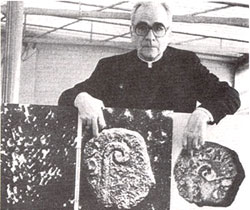
Our historical investigation finds striking confirmation through palaeography, which dates the image to within two years. Our late lamented friend, Father Filas, sent us the complete file of this discovery, which, to his credit, he brought to completion though not having initiated it himself. This fact needs to be recalled, for it all began with a consensus of American scientists, vouched for by the preliminary work of the STURP team at Albuquerque in 1977 and by Jumper's communication to the Congress of Turin in 1978. But it all ended in such a persecution of Father Filas starting from the meeting at Los Alamos in 1979, that to this day his file is as good as banned worldwide.
Why? For one reason only, which is totally alien to science: because we have here a dating of the image, and not just of the cloth, dating it to almost the actual year of the Event itself. It is the stamp or seal of Pontius Pilate, giving a date to which no scientist can raise any objection. Unless he maintains, as does Laurentin, who wrote to me saying that he can see nothing! Might as well deny the light of day in broad daylight. Judge for yourselves.
PILATE'S LEPTON
It is the three-dimensional analysis (see below) which gave birth to this hypothesis, but even a look at an ordinary photograph will clearly reveal a kind of disc placed over each eyelid, dark on the positive and light on the negative.
|
|
AN ANOMALY THAT DOES NOT DECEIVE
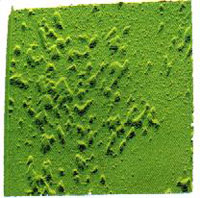
Confirmed by three-dimensional analysis (see below), the discovery was found to be definitively corroborated by its very fruitfulness, for it led to some unexpected progress in numismatic science. Four Greek letters, Y CAI, are in fact all that are needed to reconstruct the inscription TIBEPIO [Y KAI] CAPOC, “ of Tiberius Caesar ”. But there is an anomaly: on the Holy Shroud a Latin C replaces the initial Greek K of KAICAPOC, which figures on all the coin collections known up to 1980.
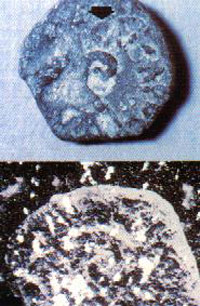
Above: a coin of Pontius Pilate with the staff surmounted by the letters CAICAPOC, with a Latin 'C' instead of the Greek 'K'.Below: the imprint superimposed on a coin of Pontius Pilate shows that the letters Y CAI form the visible part on the Holy Shroud of the Greek inscription:TIBEPIO [Y CAI] CAPOC,
"of Tiberius Caesar ”, with the same anomaly: 'C' instead of 'K'.
Thereafter, to those who accused Father Filas of letting his imagination run away with him or of taking his desires for reality, he answered that, not being a numismatist, he had so little desire to see a coin of Pilate's that “ before I accidentally stumbled on this, he wrote to me, I would not have known a Pilate coin from a hole in the wall ”. He was obliged, therefore, to consult the numismatic specialists, and it was then that his discovery proved to be so little the work of his imagination that it was responsible for a positive progress in the study of numismatics itself. It revealed that the anomaly observed on the Holy Shroud and already recognised as being of common usage in inscriptions but hitherto unknown in numismatics, existed identically on other collection coins struck under Pontius Pilate, which no one had noticed before.
We have here a document dated within a year or two by the express Will of Him Who caused this Image to be imprinted on the cloth. For one would have expected to see shards of broken pottery used for covering the eyes, as was the Jewish custom, but it would not have been possible to read a date from them. Whereas the little coin proclaims: it is “ under Pontius Pilate ” that this Man suffered.
